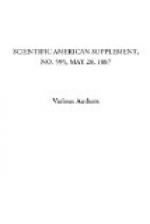[Illustration: VANDERPOEL’S SETTLING TUBES.]
The tube shown at 4 is, we think, an improvement upon all of the foregoing, for upon it there is no side tube to break off, and everything is comprised in a small space. As will be seen by referring to the figure, there is a slight enlargement in the ground portion of the stopper end of the tube, this protuberance coming down about one-half the length of the stopper, which is solid and ground to fit perfectly. The lower half, however, is provided with a small longitudinal slit or groove, the lower end of which communicates with the interior of the tube, while the upper end just reaches the enlargement in the side of the latter. Thus in one position of the stopper there is a communication between the tube and the outer air, while in all other positions the tube is quite shut. In all these tubes care must be taken to fill them completely with the urine, and to allow no bubbles of air to remain therein.
The first of these settling tubes was made without the ground cap on the lower end, the latter being inserted into a small test tube for safety. At the suggestion of Mr. J.L. Smith the test tube was made a part of the apparatus by fitting it (by grinding) upon the conical end, and in its present form it serves to protect the latter from dust and to prevent evaporation of the urine (or other liquid), and consequent deposition of salts, if, for any reason, the user should allow the tube to remain suspended for several days.
These tubes will be found very useful for collecting and concentrating into a small bulk the sediment contained in any liquid, whether it be composed of urinary deposits, diatoms in process of being cleaned, or any thing of like nature; and, as the parts are all of glass, the strongest acids may be used, excepting, of course, hydrofluoric acid, without harm to the tubes.—American Microscopical Journal.
* * * * *
[Continued from SUPPLEMENT, No. 594, page 9491.]




